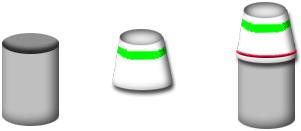

| Rub the cloth and make the match... without looking. | Square with a straight stitch |  |
Directions for Squares
1. Cut two rectangles of cloth 6 inches by 3 inches from one kind of material.
2. Cut two rectangles from each of the other types of cloth.
3. Fold one rectangle in half
 |
 |
Directions for blindfold
1. Cut the pattern and the ties from dark felt material. The ties are 12
inches long.
2. Sew on the ties well.
3. You can decorate the outside of the mask with fabric paint.

Directions for Feely Can
1. Wrap plastic tape or masking tape around the inside top edge of a large coffee can. (This covers any sharp metal near the rim.)
2. Cover the outside of the can with paper or contact and decorate it.
3. Cut off the end of an old pair of sweat pants or adult socks.
4. Put the cut end around the can's opening. Tie it on or use rubberbands
to hold it in place.

Young children under 3 or 4 years do not usually like the blindfold. They will reach their hands in the feely can.
Older kids like the blindfold because it helps them to cover their eyes. It Is hard to close your eyes and not peak. For children who want to be successful, it is more normal to peak.
Games for the texture squares
1. Rub one square be your finger tips. Rub another square until you
find a match.
Is it easier to match your squares when you rub both squares at the same time.. or rub them separately?
How can you separate the squares so that you don't keep feeling the same square over and over? What search strategy can you use?
One more game is feeling the texture, walking across the room and feeling for the match. Keeping the memory of the texture in your head is a hard job.
2. Use your eyes. Little children can make a match with their eyes as well as their fingers. They can see the texture.
They can learn color from the Same too.
3. Rub a square on part of the body. CHEEKS, TOES! Ask the child If the next square is the "same or different" (The language is important to building the feelings behind these two words.) What other body parts can you rub?
4. Rough and smooth... These are two more words that describe texture. Ask a child to choose the smoothest material. From the squares left, he/she can choose the smoothest, then from the ones remaining, again he/she chooses the smoothest. When all are done, the child has a gradation or scale of smooth to rough.
Children can go from rough to smooth.
They can go around the house and find smooth and rough textures.
They can find other materials paper or cloth, and make their own texture squares.
5. Use the feely can or blindfold for more games. Put objects in the can to feel and name.
Start with easy objects like a spoon, key, ball and lid. These are real, every day objects.
Harder objects are "representations." A small car and a plastic animal aren't real cars and but children often play with them
Even harder objects are shapes like cardboard circles squares and triangles or plastic or cardboard letters. The label is their shape and not the actual item itself.
6. What other games can you add here.
How and where are you going to store your new texture squares? When will you play them with your children?
|
|
|
|||||||||
| ||||||||||